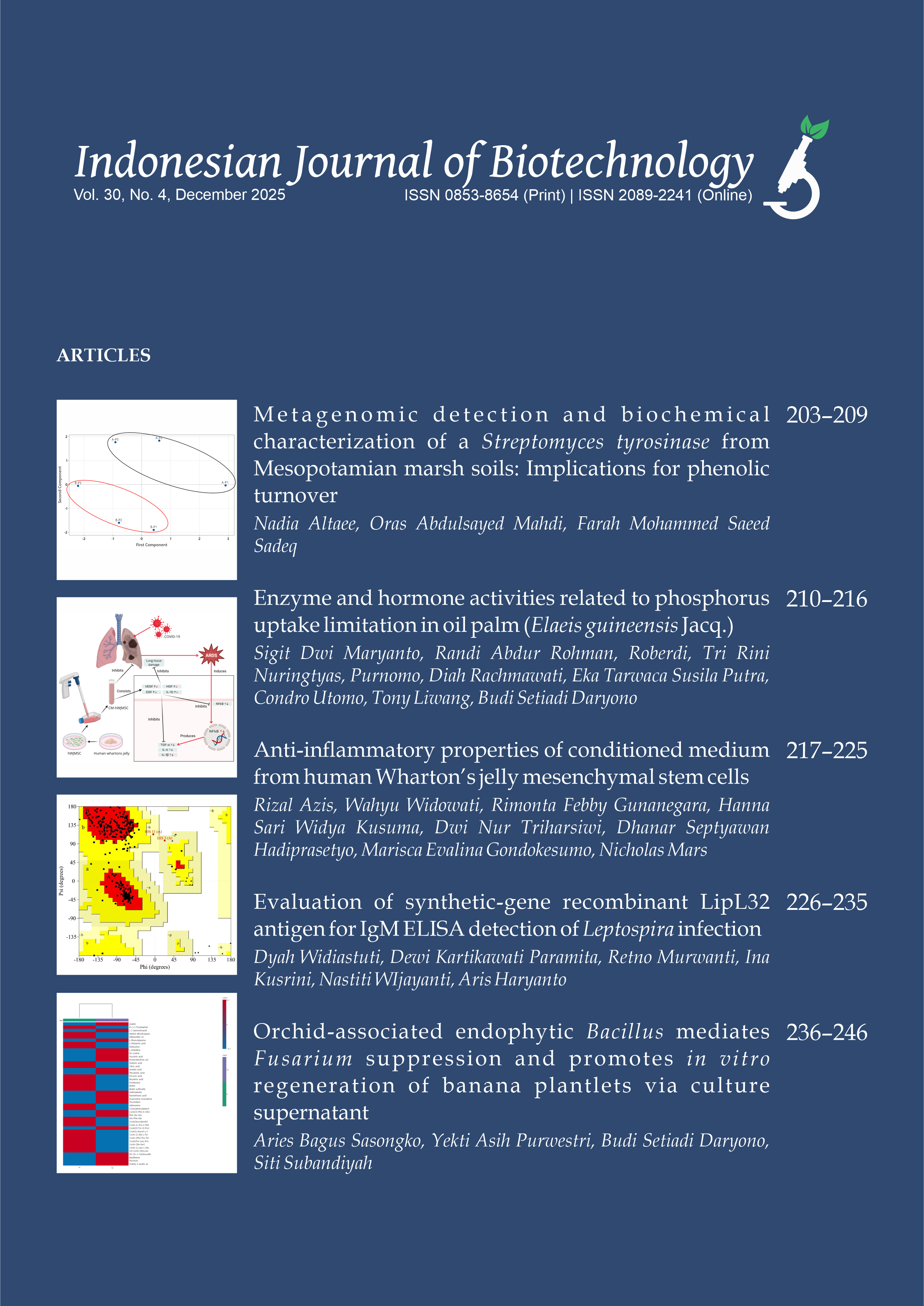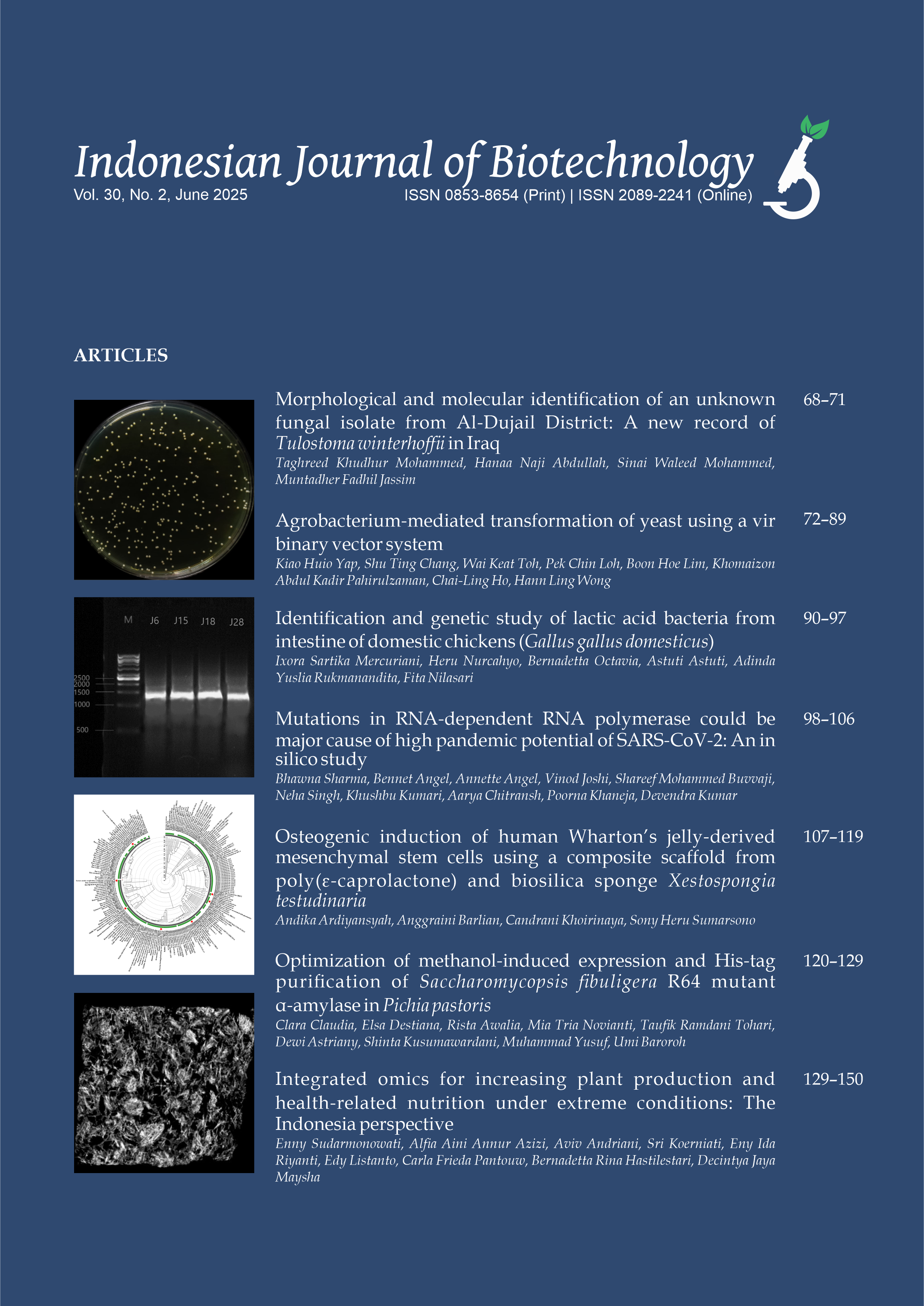Molecular bird sexing of sulphur‐crested cockatoo (Cacatua galerita) by polymerase chain reaction method
Diana Savitri(1), Irhamna Putri(2), Warih Pulung Nugrahani(3), Medania Purwaningrum(4), Aris Haryanto(5*)
(1) Department of Biochemistry and Molecular Biology, Faculty of Veterinary Medicine, Universitas Gadjah Mada, Jl. Fauna 2, Karangmalang, Yogyakarta 55281
(2) Wildlife Rescue Centre (WRC), Jl. Pengasih‐Nanggulan, Pengasih, Kulon Progo, Yogyakarta 55652, Indonesia
(3) Wildlife Rescue Centre (WRC), Jl. Pengasih‐Nanggulan, Pengasih, Kulon Progo, Yogyakarta 55652, Indonesia
(4) Department of Biochemistry and Molecular Biology, Faculty of Veterinary Medicine, Universitas Gadjah Mada, Jl. Fauna 2, Karangmalang, Yogyakarta 55281
(5) Department of Biochemistry and Molecular Biology, Faculty of Veterinary Medicine, Universitas Gadjah Mada, Jl. Fauna 2, Karangmalang, Yogyakarta 55281
(*) Corresponding Author
Abstract
Sex identification of endangered and protected birds in captivity is very important for conservation programs. Half of the world’s bird species are monomorphic, where male and female are difficult to distinguished morphologically, including cockatoos. Sex identification using molecular bird sexing is more accurate and applicable because it directly targets the sex chromosomes. The purpose of this study was to determine the sex of Sulphur‐crested cockatoo (Cacatua galerita) by detecting differences in the intron size of the chromodomain helicase DNA‐binding 1 (CHD1) gene on the Z and W chromosomes by polymerase chain reaction (PCR) method and to compare of plucked feathers and blood samples as DNA sources for molecular bird sexing. DNA was extracted from feather and blood samples from four C. galerita. Extracted DNA was amplified on the CHD1 gene by PCR method with P2, MP, and NP primers, which were visualized using agarose gel 1.5% under UV transilluminator with a wavelength of 280 nm. The resulting PCR product was detected at 392 bp for the CHD1 Z gene segment and 297 bp for CHD1 W gene segments, where males showed a single DNA band (ZZ) and females showed a double DNA band (ZW). Four C. galerita were 100% successfully determined, consisting of one female and three males. Electrophoresis results showed DNA bands from blood samples were thicker and brighter than DNA bands from feather samples.
Keywords
Full Text:
PDFReferences
Angat J, Yusof FZM. 2015. A noninvasive technique for sex determination of monomorphic birds. Malays Appl Biol.s 44(4):27–30.
Beehler BM, Pratt TK, Zimmerman DA. 2001. Burungburung di Kawasan Papua. Indonesian Edition. Bogor: Puslitbang BiologiLIPI.
Beno M, Ohee HL. 2009. Pengetahuan Konservasi Tradisional Burung Endemik pada Masyarakat Kampong Soaib di Distrik Kemtuk, Kabupaten Jayapura. J Biol Papua. 1(1):15–19.
BirdLifeInternational. 2019. Cacatua galerita: The IUCN Red List of Threatened Species 2018: e.T22684781A13191497. URL https://dx.doi.org/10.2305/IUCN.UK.20182.RL TS.T22684781A131914971.en. Accessed: 202001 18.
Cakmak E, Peksen CA, Bilgin CC. 2017. Comparison of three different primer sets for sexing birds. J Vet Diagn Invest. 29(1):59–63. doi:10.1177/1040638716675197.
Cerit H, Avanus K. 2007. Sex identification in avian species using DNA typing methods. World’s Poult Sci J. 63(1):91–99. doi:10.1079/WPS2006131.
Dubiec A, ZagalskaNeubauer M. 2006. Molecular Techniques for Sex Identification in Birds. Biological Lett. 43(1):3–12.
Ellegren H. 1996. First gene on the avian W chromosome (CHD) provides a tag for universal sexing of nonratite birds. Proc R Soc B. 263(1377):1635–1641. doi:10.1098/rspb.1996.0239.
Foreshaw JM. 2010. Parrots of the World. Collingwood: CSIRO Publishing.
Fridolfsson AK, Ellegren H. 1999. A simple und universal method for molecular sexing of nonratite birds. J Avian Biol. 30(1):116–121.
Garofalo L, Fanelli R, Opramolla G, Polidori M, Tancredi F, Altea T, Posillico M, Lorenzini R. 2016. Comparison between Two molecular protocols for sex determination in birds, with implications for the management and conservation of the eurasian Griffon vulture Gyps fulvus. Avocetta. 40(1):17–22.
Grant A. 2001. DNA Sexing of Brown Kiwi (Apteryx mantelli) from Feather Samples. Wellington: Department of Conservation.
Griffiths R, Double MC, Orr K, Dawson JG. 1998. A DNA test to sex most birds. Mol Ecol. 7(8):1071–1075. doi:10.1046/j.1365294x.1998.00389.x.
Griffiths R, Korn R. 1997. A CHD1 gene is Z chromosome linked in the chicken Gallus domesticus. Gene. 197(1 2):225–229. doi:10.1016/s03781119(97)002667.
Harvey MG, Bonter DN, Stenzler LM, Lovette IJ. 2006. A comparison of plucked feathers versus blood samples as DNA sources for molecular sexing. J Field Ornithol. 77(2):136–140. doi:10.1111/j.1557 9263.2006.00033.x.
Hay R. 2008. Sulphurcrested Cockatoo (Cacatua galerita), Exports from New Zealand, Case Study. URL https://www.cites.org/sites/default/files/ndf_ma terial/WG6CS3B.pdf. Accessed: 20200118.
Hickman CPJ, Roberts LS, Hickman FM. 1984. Integrated Principles of Zoology. 7th Edition. Toronto: Mosby Collage Publishing.
Ito HA, Abe M, Murase T, Tsubota T. 2003. Sex identification by alternative polymerase chain reaction methods in Falconiformes. Zool Sci. 20(3):339–344. doi:10.2108/zsj.20.339.
Khaerunnisa I, Sari E, Ulfah M, Jakaria SC. 2013. Avian sex determination based on chromo helicase DNAbinding (CHD) genes using polymerase chain reaction (PCR). Media Peternakan. 36(2):85–90. doi:10.5398/medpet.2013.36.2.85.
Liu H, Li J, Yang F, Cai Y. 2011. Molecular sexing of endangered cranes based on CHDW gene. J Appl Anim Res. 39(3):212–217. doi:10.1080/09712119.2011.565225.
Morinha F, Cabral JA, Bastos E. 2012. Molecular sexing of birds: A comparative review of polymerase chain reaction (PCR)based methods. Theriogenology. 78(4):703–714. doi:10.1016/j.theriogenology.2012.04.015.
Nugroho HA, Zein MSA. 2015. Evaluasi metode penentuan jenis kelamin pada nuri kepala hitam (Lorius lory, Linnaeus 1758. J Fauna Tropika. 24(2):89–93.
Purwaningrum M, Nugroho HA, Asvan M, Karyanti K, Alviyanto B, Kusuma R, Haryanto A. 2019. Molecular techniques for sex identification of captive birds. Vet World. 12(9):1506–1513. doi:10.14202/vetworld.2019.15061513.
Ravindran S, Woo WK, Saufi S, Amni WN, Hamid NH, Abidin CMRZ, Ishak I, Azzam G, Salim H. 2019. Molecular Sexing of Southeast Asian Barn Owl, Tyto alba javanica, using Blood and Feather. Trop Life Sci Res. 30(2):13–23. doi:10.21315/tlsr2019.30.2.2.
Rowley I, Kirwan GM. 2016. Handbook of the Birds of the Wold Alive: SulphurCrested Cockatoo (Cacatua galerita). Barcelona: Lynx Editions.
Vucicevic M, StevanovPavlovic M, Stevanovic J, Bosnjak J, Gajic B, Aleksic N, Stanimirovic Z. 2013. Sex Determination in 58 Bird Species and Evaluation of CHD Gene as a Universal Molecular Marker in Bird Sexing. Zoo Biol. 32(3):269–276. doi:10.1002/zoo.21010.
WorldParrotTrust. 2018. SulphurCrested Cockatoo (Cacatua galerita). URL https://www.parrots.org/ency clopedia/sulphurcrestedcockatoo. Accessed: 2020 0118.
Article Metrics
Refbacks
- There are currently no refbacks.
Copyright (c) 2021 The Author(s)

This work is licensed under a Creative Commons Attribution-ShareAlike 4.0 International License.









